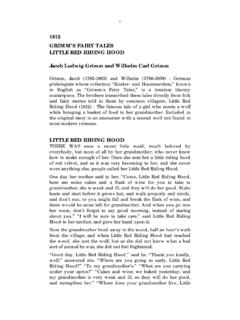Transcription of Steelmaking: The Coke Oven By-Product Plant
1 The coke Oven By-Product PlantContributed by Mick Platts, ThyssenKrupp EnCoke USAT able of Contents l What is it and what does it do? l coke oven / By-Product Plant interfacel Composition of coke oven gasl Duties of the By-Product plantl The By-Product Plant gas trainl Primary cooler l Tar precipitatorsl Exhausterl Ammonia removall Final coolerl Naphthalene removall Light oil removall coke oven gas desulfurizationl Tar and Liquor Plantl Conclusion WHAT IS IT AND WHAT DOES IT DO? The coke oven By-Product Plant is an integral part of the By-Product cokemaking process . In the process of converting coal into coke using the By-Product coke oven, the volatile matter in the coal is vaporized and driven off. This volatile matter leaves the coke oven chambers as hot, raw coke oven gas. After leaving the coke oven chambers, the raw coke oven gas is cooled which results in a liquid condensate stream and a gas stream.
2 The functions of the By-Product Plant are to take these two streams from the coke ovens , to process them to recover By-Product coal chemicals and to condition the gas so that it can be used as a fuel gas. Historically, the By-Product chemicals were of high value in agriculture and in the chemical industry, and the profits made from their sale were often of greater importance than the coke produced. Nowadays however most of these same products can be more economically manufactured using other technologies such as those of the oil industry. Therefore, with some exceptions depending on local economics, the main emphasis of a modern coke By-Product Plant is to treat the coke oven gas sufficiently so that it can be used as a clean, environmentally friendly oven / By-Product Plant interfaceIn a By-Product coke oven the evolved coke oven gas leaves the coke oven chambers at high temperatures approaching 2000()()F. This hot gas is immediately quenched by direct contact with a spray of aqueous liquor (flushing liquor).
3 The resulting cooled gas is water saturated and has a temperature of 176()()F. This gas is collected in the coke oven battery gas collecting main. From the gas collecting main the raw coke oven gas flows into the suction main. The amount of flushing liquor sprayed into the hot gas leaving the oven chambers is far more than is required for cooling, and the remaining unevaporated flushing liquor provides a liquid stream in the gas collecting main that serves to flush away condensed tar and other compounds. This stream of flushing liquor flows under gravity into the suction main along with the raw coke oven gas. The raw coke oven gas and the flushing liquor are separated using a drain pot (the downcomer) in the suction main. The flushing liquor and the raw coke oven gas then flow separately to the By-Product Plant for of coke oven gasRaw coke oven gas coming from the coke oven battery has the following typical composition: Dry basisActual composition (water saturated at 176 F)Water vapor-47%Hydrogen55%29%Methane25%13%Nitr ogen10%5%Carbon Monoxide6%3%Carbon Dioxide3%2%Hydrocarbons (ethane, propane etc.)
4 2%1%Raw coke oven gas also contains various contaminants, which give coke oven gas its unique characteristics. These consist of:l Tar vaporsl Light oil vapors (aromatics), consisting mainly of benzene, toluene and xylene (BTX)l Naphthalene vaporl Ammonia gasl Hydrogen sulfide gasl Hydrogen cyanide gas TopDuties of the By-Product plantIn order to make raw coke oven gas suitable for use as a fuel gas at the coke oven battery and elsewhere in the steelmaking facility the By-Product Plant must:l Cool the coke oven gas to condense out water vapor and contaminantsl Remove tar aerosols to prevent gas line/equipment fouling l Remove ammonia to prevent gas line corrosionl Remove naphthalene to prevent gas line fouling by condensationOther duties may include:l Remove light oil for recovery and sale of benzene, toluene and xylenel Remove hydrogen sulfide to meet local emissions regulations governing the combustion of coke oven addition to treating the coke oven gas, the By-Product Plant must also condition the flushing liquor that is returned to the coke oven battery, and treat the waste water that is generated by the coke making By-Product Plant gas trainThe gas treatment processes in the By-Product Plant typically consist of the following Plant items, arranged in the order in which they are coolerThe first step in the treatment of raw coke oven gas is to cool it to remove water vapor and so greatly reduce its volume.
5 This is done in the Primary Cooler. There are two basic types, the spray type cooler and the horizontal tube type. In a spray type cooler the coke oven gas is cooled by direct contact with a recirculated water spray, with the contact cooling water being itself cooled externally in heat exchangers. In the tubular type, the coke oven gas is cooled indirectly by flowing across horizontally mounted tubes through which cooling water is pumped. In this case, the cooling water does not come into contact with the coke oven gas and so it can be cooled in a cooling tower for example. As the coke oven gas is cooled, water, tar and naphthalene condense out. The condensate collects in the primary cooler system and is discharged to the tar & liquor precipitatorsAs the raw coke oven gas is cooled, tar vaporcondenses and forms aerosols which are carried along with the gas flow. These tar particles would contaminate and foul downstream processes and would foul gas lines and burner nozzles if allowed to continue in the gas stream.
6 The tar precipitators typically use high voltage electrodes to charge the tar particles and then collect them from the gas by means of electrostatic attraction. The tar precipitators can be installed before, or after the exhauster. The usual practice in North America is to place them immediately after the exhauster is a large blower that provides the motive force to induce the coke oven gas to flow from the coke oven battery and through the By-Product Plant . The exhauster is of prime importance to the operation of the coke oven battery. It allows the close control of the gas pressure in the collecting main, which in turn affects the degree of emissions, for example door emissions, from the battery. A failure of the exhauster will immediately result in venting to atmosphere, through the battery flares, of all of the raw coke oven gas produced. TopAmmonia removalBecause of the corrosive nature of ammonia, its removal is a priority in coke oven By-Product plants.
7 Historically the removal of ammonia from coke oven gas has yielded one of the more profitable by-products, that of ammonium sulfate. The ammonium sulfate process can take various forms but all basically involve contacting the coke oven gas with a solution of sulfuric acid. Variations include the use of an absorber, in which the sulfuric acid solution is sprayed into the gas, or the use of a saturator in which the gas is bubbled through a bath of sulfuric acid solution. The sulfuric acid reacts readily with the ammonia in the coke oven gas to form ammonium sulfate. This is then crystallized out, removed from the solution and dried for sale typically as a fertilizer. Nowadays the cost to produce ammonium sulfate often outweighs the revenue from the product , however there are still very many coke plants around the world producing ammonium sulfate. More modern processes for ammonia removal include the water wash process in which the coke oven gas is scrubbed by water, which dissolves the ammonia, along with some hydrogen sulfide and hydrogen cyanide.
8 The resulting scrubbing solution is pumped to an ammonia still where steam is used to strip out the ammonia. The ammonia vapors from the still can be processed to form ammonium sulfate similar to the processes described above, condensed to form a strong ammonia solution, incinerated or catalytically converted to nitrogen and hydrogen which are then recycled back into the coke oven gas. The incineration of the ammonia vapors is usually not an option in areas where environmental laws restrict the emission of NOx and sulfur process for ammonia removal from coke oven gas is the PHOSAM process developed by US Steel. This process absorbs the ammonia from the coke oven gas using a solution of monoammonium phosphate. The process produces saleable anhydrous ammonia. TopFinal coolerThe duty of the final cooler is to remove the heat of compression from the coke oven gas that it gained on flowing through the exhauster. This is necessary because the efficiency of many of the By-Product Plant processes, including the water wash ammonia removal process , is greatly improved at lower temperature.
9 The final cooler is therefore placed upstream of water wash ammonia scrubbers if these are installed. Final coolers typically cool the coke oven gas by direct contact with a cooling medium, either water or wash oil. An important aspect of final cooler operation is that when the coke oven gas is cooled below the outlet temperature of the primary cooler, naphthalene will condense from the gas. This naphthalene readily crystallizes out from the cooling medium and will foul equipment if not disposed of. In wash oil final coolers the naphthalene dissolves in the wash oil and a side stream of oil is steam stripped to remove the naphthalene. If water is used to cool the coke oven gas, the condensed naphthalene must be absorbed using tar. The tar is either entrained in the cooling water, with a portion of the flow being continuously blown down for treatment, or it takes the form of a tar layer through which the cooling water flows.
10 The tar is continuously exchanged with fresh tar from the tar and liquor Plant to dispose of the absorbed removalNaphthalene is removed from coke oven gas using wash oil in a gas scrubbing vessel. The vessel may be packed or it may be the "void" type in which the wash oil is sprayed into the gas in several stages. The wash oil is regenerated by stripping out the naphthalene from the wash oil using steam in a still. In many plants, naphthalene removal is integrated with the similar process of light oil removal. The naphthalene is typically recovered as a heavier oil stream that is then often mixed with the tar that is produced in the By-Product oil removalLight oil is a general term for a mixture of similar chemicals consisting mainly of benzene, toluene and xylene. The removal of light oil from coke oven gas uses wash oil in a similar process to that described for naphthalene removal. The light oil is stripped from the wash oil in a still and is then condensed to form crude light oil.

